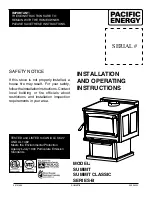
DISPOSAL OF MATERIALS
WARNINGS FOR THE CORRECT DISPOSAL OF THE PRODUCT
The owner is the sole party responsible for demolishing and disposing of the product. This must be performed in compliance with
laws related to safety and environmental protection in force in his/her country.
At the end of its working life, the product must not be disposed of as urban waste.
It must be taken to a special differentiated waste collection centre set up by the local authorities or to a retailer that provides this
service.
Separating and recycling prevents potential negative effects on the environment and health (often caused by inappropriately
disposing of product parts). It also allows materials to be recovered in order to obtain significant savings in energy and resources.
The following table and the exploded view it refers to highlight the main components that can be found in the device and indica-
tions on how to separate and dispose of them correctly when no longer used.
More specifically, the electric and electronic components must be separated and disposed of in authorised centres, in compliance
with the WEEE directive 2012/19/EU and the relative national transpositions.
Exploded drawing
LEGENDA
WHERE TO DISPOSE
MATERIALS
A. OUTER CLADDING
If there is any, to be disposed of separately based on
the material used:
Metal
Glass
Tiles or ceramics
Stone
B. GLASS DOORS
If there is any, to be disposed of separately based on
the material used:
Glass ceramic (fire door): to be disposed of with inert
or mixed waste
Tempered glass (oven door): to be disposed of with
glass
C. INTERIOR CLADDING
If there is any, to be disposed of separately based on
the material used:
Metal
Refractory materials
Insulating panels
Vermiculite
Insulation, vermiculite and refractory materials that
have come into contact with flames or exhaust gases
(dispose of in mixed waste)
Summary of Contents for INDIGO
Page 42: ...NOTE...
Page 43: ...NOTE...







































